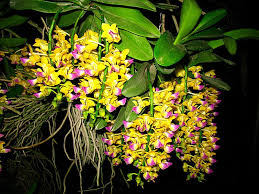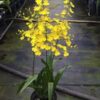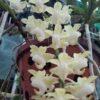# How to Combine Quế Lan Hương Orchids with Other Plants in the Garden

Quế Lan Hương orchids (*Dendrobium anosmum*) are not only celebrated for their stunning beauty and enchanting fragrance but also for their adaptability in various garden settings. Integrating these exquisite orchids with other plants can create a vibrant and harmonious landscape. In this article, we will explore effective strategies for combining Quế Lan Hương orchids with other plant species, considering aspects such as aesthetics, growth requirements, and companion planting principles.
## 1. Understanding Quế Lan Hương Orchids
### 1.1 Botanical Characteristics
Quế Lan Hương orchids are native to tropical regions of Southeast Asia, known for their epiphytic growth habit, where they thrive on trees and absorb moisture and nutrients from the air. These orchids produce long, slender stems adorned with clusters of fragrant flowers, typically ranging from white to lavender. Understanding their growth patterns, light, and water requirements is essential for successful integration into the garden.
### 1.2 Ideal Growing Conditions
Quế Lan Hương orchids prefer warm, humid environments with bright, indirect light. They thrive in well-draining, organic-rich substrates that mimic their natural habitat. Regular watering is crucial during the growing season, while a slight reduction in moisture is advisable during dormancy.
## 2. Selecting Companion Plants
Choosing the right companion plants to pair with Quế Lan Hương orchids is essential for creating a visually appealing and ecologically balanced garden. Here are some considerations when selecting companion plants:
### 2.1 Compatibility with Growth Requirements
It’s crucial to choose plants that have similar light and moisture requirements. For instance, pairing orchids with ferns, bromeliads, or certain tropical plants can create a microclimate that benefits both types of vegetation.
### 2.2 Aesthetic Harmony
Color, texture, and form play a vital role in creating an attractive garden layout. Selecting plants that complement the colors of the Quế Lan Hương orchids can enhance the overall visual appeal. For instance, pairing orchids with plants that have contrasting foliage or bloom colors can create a stunning display.
### 2.3 Pollinator-Friendly Choices
Incorporating plants that attract pollinators can benefit the overall health of the garden and improve the orchid’s pollination success. Plants such as butterfly bush (*Buddleja*), salvia, and lavender can attract bees and butterflies, fostering a vibrant ecosystem.
## 3. Recommended Companion Plants for Quế Lan Hương Orchids
Here are some excellent companion plants to consider when designing a garden featuring Quế Lan Hương orchids:
### 3.1 Ferns
Ferns are a fantastic choice to pair with Quế Lan Hương orchids due to their similar moisture and light requirements. They thrive in shaded areas and help create a lush, tropical environment that mimics the orchids’ natural habitat. Some suitable fern varieties include:
– **Boston Fern (*Nephrolepis exaltata*)**: Known for its feathery fronds, the Boston fern adds a soft texture to the garden and prefers high humidity.
– **Maidenhair Fern (*Adiantum*)**: With delicate, fan-shaped fronds, maidenhair ferns provide a charming contrast to the more robust orchid leaves.
### 3.2 Bromeliads
Bromeliads are another excellent companion for Quế Lan Hương orchids. These colorful plants thrive in similar conditions and can be mounted on trees or rocks, mimicking the orchids’ epiphytic nature. Some suitable bromeliad varieties include:
– **Guzmania**: Known for their vibrant inflorescences, Guzmania bromeliads add a pop of color to the garden.
– **Tillandsia**: Commonly referred to as air plants, Tillandsia varieties can be placed among orchids without soil, absorbing moisture from the air.
### 3.3 Tropical Foliage Plants
Incorporating tropical foliage plants can create a stunning backdrop for your Quế Lan Hương orchids. Here are some ideal candidates:
– **Philodendron**: With its lush, heart-shaped leaves, philodendron provides a tropical feel while thriving in similar light conditions as orchids.
– **Monstera Deliciosa**: Known for its large, perforated leaves, Monstera can create a dramatic effect in the garden and enjoys similar humidity levels.
### 3.4 Pollinator-attracting Flowers
To enhance biodiversity and attract pollinators, consider incorporating the following flowering plants:
– **Lantana**: This hardy plant produces vibrant clusters of flowers that attract butterflies and bees, complementing the orchids’ bloom time.
– **Zinnias**: Known for their bright colors, zinnias bloom profusely and attract a variety of pollinators.
– **Lavender**: With its aromatic flowers, lavender not only attracts bees but also pairs beautifully with the fragrance of Quế Lan Hương orchids.
### 3.5 Ground Covers
Using ground covers can help retain moisture and suppress weeds, benefiting the orchids. Consider:
– **Creeping Thyme**: This aromatic herb thrives in well-drained soil and provides a lovely mat of greenery under orchids.
– **Moss**: For a natural look, moss can be planted around the base of orchids to create a humid microenvironment.
## 4. Designing the Garden Layout
### 4.1 Vertical Gardening
Quế Lan Hương orchids thrive in vertical spaces, making them ideal for hanging gardens or vertical planters. You can mount orchids on wooden boards, tree trunks, or specially designed orchid holders. Combine these with trailing plants like *Pothos* or *Hoya* to create a lush, layered effect.
### 4.2 Layering Techniques
When designing your garden, consider layering plants of varying heights to create visual interest. Place taller plants like Monstera at the back or center of the garden bed, with medium-height plants like ferns and bromeliads in the middle and shorter flowering plants at the front. This layering technique allows each plant to be showcased while maximizing space and creating a harmonious garden design.
### 4.3 Creating Microclimates
Utilize rocks, mulch, and other materials to create microclimates that cater to the needs of Quế Lan Hương orchids and their companions. For instance, adding a layer of mulch can help retain moisture in the soil, benefiting moisture-loving plants while providing insulation against temperature fluctuations.
### 4.4 Using Containers
If space is limited, consider using containers to house Quế Lan Hương orchids and their companions. Grouping plants in pots allows for flexibility in design, making it easy to rearrange or relocate them as needed. Use decorative pots to enhance the aesthetic appeal of the garden.
## 5. Caring for Your Mixed Garden
Maintaining a garden that combines Quế Lan Hương orchids with other plants requires attention to several key factors:
### 5.1 Watering
Ensure that all plants receive appropriate watering, considering their individual needs. Quế Lan Hương orchids prefer to dry out slightly between waterings, while ferns and bromeliads may require more consistent moisture. Regularly check soil moisture levels to avoid overwatering or underwatering.
### 5.2 Fertilization
Incorporate a balanced fertilizer that caters to both orchids and companion plants. Fertilize during the growing season to provide essential nutrients for flowering and overall health. Organic fertilizers can be beneficial, as they promote a healthy soil ecosystem.
### 5.3 Pest Management
Monitor your garden for pests that may affect both orchids and companion plants. Employ integrated pest management (IPM) strategies, such as introducing beneficial insects like ladybugs, to control pest populations naturally. Avoid using chemical pesticides that may harm pollinators and beneficial insects.
### 5.4 Pruning and Maintenance
Regularly prune and deadhead companion plants to encourage new growth and maintain the overall appearance of the garden. Remove any dead or diseased foliage to prevent the spread of pests and diseases.
## 6. Conclusion
Combining Quế Lan Hương orchids with other plants can create a stunning and vibrant garden that enhances the beauty of these remarkable orchids while supporting a diverse ecosystem. By selecting compatible companion plants, designing an appealing layout, and providing proper care, gardeners can cultivate a flourishing environment that showcases the elegance of Quế Lan Hương orchids.
As we continue to explore the possibilities of gardening, let us celebrate the beauty of nature by integrating these exquisite orchids with a variety of other plant species. Through thoughtful design and care, we can create a garden that not only thrives but also inspires and delights. Whether in a small balcony or a sprawling landscape, the combination of Quế Lan Hương orchids with other plants can transform any space into a botanical paradise.

